Spatial Characteristics, Health Risk Assessment and Sustainable Management of Heavy Metals and Metalloids in Soils from Central China
Abstract
:1. Introduction
2. Materials and Methods
2.1. Study Area
2.2. Data Collection and Processing
2.3. Geoaccumulation Index
2.4. Health Risk Assessment
2.5. Statistics Methods
3. Results and Discussion
3.1. Overview of Concentrations of Soil Metals in Central China
3.2. Spatial Distribution Patterns of Toxic Metals in Central China
3.3. Geoaccumulation Indexes of Metals
3.4. Human Health Assessment of Children and Adults in Central China
3.5. Correlation Analysis
3.6. Sustainable Management
4. Conclusions
Supplementary Materials
Acknowledgments
Author Contributions
Conflicts of Interest
References
- Hu, Y.; Cheng, H. Application of stochastic models in identification and apportionment of heavy metal pollution sources in the surface soils of a large-scale region. Environ. Sci. Technol. 2013, 47, 3752–3760. [Google Scholar] [CrossRef] [PubMed]
- Odukudu, F.B.; Ayenimo, J.G.; Adekunle, A.S.; Yusuff, A.M.; Mamba, B.B. Safety evaluation of heavy metals exposure from consumer products. Int. J. Consum. Stud. 2014, 38, 25–34. [Google Scholar] [CrossRef]
- Li, F.; Huang, J.; Zeng, G.M.; Huang, X.L.; Liu, W.C.; Wu, H.P. Spatial distribution and health risk assessment of toxic metals associated with receptor population density in street dust: A case study of Xiandao District, Changsha, Middle China. Environ. Sci. Pollut. Res. 2015, 22, 6732–6742. [Google Scholar] [CrossRef] [PubMed]
- Duan, X.W.; Zhang, G.L.; Rong, L.; Fang, H.Y.; He, D.M.; Feng, D.T. Spatial distribution and environmental factors of catchment scale soil heavy metal contamination in the dryhot valley of Upper Red River in southwestern China. Catena 2015, 135, 59–69. [Google Scholar] [CrossRef]
- Wu, S.H.; Shi, Y.X.; Zhou, S.L.; Wang, C.H.; Chen, H. Modeling and mapping of critical loads for heavy metals in Kunshan soil. Sci. Total Environ. 2016, 191, 569–570. [Google Scholar] [CrossRef] [PubMed]
- Li, F.; Zhang, J.D.; Jiang, W.; Liu, C.Y.; Zhang, Z.M.; Zhang, C.D.; Zeng, G.M. Spatial health risk assessment and hierarchical risk management for mercury in soils from a typical contaminated site, China. Environ. Geochem. Health 2017, 39, 923–934. [Google Scholar] [CrossRef] [PubMed]
- Culbard, E.B.; Thornton, I.; Watt, J.; Wheatley, M.; Moorcroft, S.; Thompson, M. Metal contamination in British urban dusts and soils. J. Environ. Qual. 1988, 17, 226–234. [Google Scholar] [CrossRef]
- Folinsbee, L.J. Human health effects of air pollution. Environ. Health Perspect. 1993, 100, 45–46. [Google Scholar] [CrossRef] [PubMed]
- Sánchez-Camazano, M.; Sánchez-Marthín, M.J.; Lorenzo, L.F. Lead and cadmium in soils and vegetables from urban gardens of Salamanca (Spain). Sci. Total Environ. 1994, 146–147, 163–168. [Google Scholar] [CrossRef]
- Madrid, L.; Diaz-Barrientos, E.; Madrid, F. Distribution of heavy metal contents of urban soils in parks of Seville. Chemosphere 2002, 49, 1301–1308. [Google Scholar] [CrossRef]
- Laidlaw, M.S.; Filippelli, G.M. Resuspension of urban soils as apersistent source of lead poisoning in children: A review and new directions. Appl. Geochem. 2008, 23, 2021–2039. [Google Scholar] [CrossRef]
- Li, H.B.; Yu, S.; Li, G.L.; Deng, H.; Luo, X.S. Contamination and source differentiation of Pb in park soils along an urban-rural gradient in Shanghai. Environ. Pollut. 2011, 159, 3536–3544. [Google Scholar] [CrossRef] [PubMed]
- Okorie, A.; Entwistle, J.; Dean, J.R. The application of in vitro gastrointestinal extraction to assess oral bioaccessibility of potentially toxic elements from an urban recreational site. Appl. Geochem. 2011, 26, 789–796. [Google Scholar] [CrossRef]
- Gong, M.; Wu, L.; Bi, X.Y.; Ren, L.M.; Wang, L.; Ma, Z.D. Assessing heavy-metal contamination and sources by GIS-based approach and multivariate analysis of urban-rural top soils in Wuhan, central China. Environ. Geochem. Health 2010, 32, 59–72. [Google Scholar] [CrossRef] [PubMed]
- Li, F.; Huang, J.; Zeng, G.M.; Huang, X.L.; Liu, W.C.; Wu, H.P. Toxic metals in topsoil under different land uses from Xiandao District, middle China: Distribution, relationship with soil characteristics, and health risk assessment. Environ. Sci. Pollut. Res. 2015, 22, 12261–12275. [Google Scholar] [CrossRef] [PubMed]
- Liang, J.; Feng, C.T.; Zeng, G.M.; Zhong, M.Z.; Gao, X.; Li, X.D.; He, X.Y.; Li, X.; Fang, Y.L.; Mo, D. Atmospheric deposition of mercury and cadmium impacts on topsoil in a typical coal mine city, Lianyuan, China. Chemosphere 2017, 189, 198–205. [Google Scholar] [CrossRef] [PubMed]
- Facchinelli, A.; Sacchi, E.; Mallen, L. Multivariate statistical and GIS-based approach to identify heavy metal sources in soils. Environ. Pollut. 2001, 114, 313–324. [Google Scholar] [CrossRef]
- Thornton, I.; Farago, M.E.; Thums, C.R.; Parrish, R.R.; McGill, R.A.; Breward, N.; Fortey, N.J.; Simpson, P.; Young, S.D.; Tye, A.M.; et al. Urban geochemistry: Research strategies to assist risk assessment and remediation of brownfield sites in urban areas. Environ. Geochem. Health 2008, 30, 565–576. [Google Scholar] [CrossRef] [PubMed] [Green Version]
- Li, F.; Huang, J.H.; Zeng, G.M.; Yuan, X.Z.; Li, X.D.; Liang, J.; Wang, X.Y.; Tang, X.J.; Bai, B. Spatial risk assessment and sources identification of heavy metals in surface sediments from the Dongting Lake, Middle China. J. Geochem. Explor. 2013, 132, 75–83. [Google Scholar] [CrossRef]
- Giller, K.E.; McGrath, S.P. Pollution by toxic metals on agricultural soils. Nature 1988, 335, 676. [Google Scholar] [CrossRef]
- Abrahams, P.W. Soils: Their implications to human health. Sci. Total Environ. 2002, 291, 1–32. [Google Scholar] [CrossRef]
- Rodrigues, S.M.; Cruz, N.; Coelho, C.; Henriques, B.; Carvalho, L.; Duarte, A.C. Risk assessment for Cd, Cu, Pb and Zn in urban soils: Chemical availability as the central concept. Environ. Pollut. 2013, 183, 234–242. [Google Scholar] [CrossRef] [PubMed]
- Teng, Y.G.; Ni, S.J.; Wang, J.S.; Zuo, R.; Yang, J. A geochemical survey of trace elements in agricultural and non-agricultural topsoil in Dexing area, China. J. Geochem. Explor. 2010, 104, 118–127. [Google Scholar] [CrossRef]
- Chen, H.M.; Zheng, C.R.; Tu, C.; Zhu, Y.G. Heavy metal pollution in soils in China: Status and countermeasures. Ambio 1999, 28, 130–134. [Google Scholar]
- Wang, Q.R.; Dong, Y.; Cui, Y.; Liu, X. Instances of soil and crop heavy metal contamination in China. Soil Sediment Contam. 2001, 10, 497–510. [Google Scholar]
- Cheng, S. Heavy metal pollution in China: Origin, pattern and control. Environ. Sci. Pollut. Res. 2003, 10, 192–198. [Google Scholar] [CrossRef]
- Huang, J.H.; Li, F.; Zeng, G.M.; Huang, X.L.; Liu, W.C.; Wu, H.P. Integrating hierarchical bioavailability and population distribution into potential eco-risk assessment of heavy metals in road dust: A case study in Xiandao District, Changsha city, China. Sci. Total Environ. 2016, 541, 969–976. [Google Scholar] [CrossRef] [PubMed]
- Tang, R.; Ma, K.; Zhang, Y.; Mao, Q. The spatial characteristics and pollution levels of metals in urban street dust of Beijing, China. Appl. Geochem. 2013, 35, 88–98. [Google Scholar] [CrossRef]
- Zhu, Y. Investigation and assessment of heavy metal in soil from Shanghaiqingpu industrial zone. Environ. Sanitat. Eng. 2017, 25, 39–42. [Google Scholar]
- Gong, M.; Wu, L.; Bi, X.Y.; Ren, L.M.; Wang, L.; Ma, Z.D.; Bao, Z.Y.; Li, Z.G. Assessing heavy-metal contamination and sources by GIS-based approach and multivariate analysis of urban-rural top soils in Wuhan, central China. Environ. Geochem. Heal. 2010, 32, 59–72. [Google Scholar] [CrossRef] [PubMed]
- Xi, C.Z.; Dai, T.G.; Huang, D.Y. Contamination characteristics of heavy metals in soil from Changsha, Hunan Province. Earth Environ. 2008, 36, 136–141. (In Chinese) [Google Scholar]
- Shen, X.; Ji, B.Y.; Tian, X.Y.; Yao, Z. Heavy metal pollution evaluation of soil in the eastern Qinghai. Geophys. Geochem. Explor. 2014, 38, 1246–1251. [Google Scholar]
- Wang, X.F.; He, C.C. Pollution characteristics and evaluation of soil heavy metals in surrounding areas of Xinxianghuanyu avenue industrial zone. Soil Bull. 2014, 43, 962–966. (In Chinese) [Google Scholar]
- Hou, Q.; Ma, J.H.; Wang, X.Y.; Duan, H.J. Biological activity and potential ecological risk of heavy metals in soils from Kaifeng kindergarten. Environ. Sci. 2011, 32, 1764–1771. (In Chinese) [Google Scholar]
- Li, Y.M.; Ma, J.H.; Liu, D.X.; Sun, Y.; Chen, Y.F. Pollution and potential ecological risk of soil heavy metal in Kaifeng city. Environ. Sci. 2015, 36, 1037–1044. (In Chinese) [Google Scholar]
- Chen, Z.F.; Fan, L.D.; Chen, Y.D.; Xing, L.T.; Yang, Y.J.; Xiang, Z.T.; Wang, X.L. Characteristics and source distribution of heavy metals in farmland soils of urban and rural area—A case study of urban and rural area in the eastern suburb of a city in Henan Province. J. Anhui Norm. Univ. (Philos. Soc. Sci. Ed.) 2016, 36, 1317–1327. (In Chinese) [Google Scholar]
- Liu, Y.N.; Zhu, S.F.; Wei, X.F.; Miao, J.; Zhou, J.; Guan, F.J. Characteristics and evaluation of heavy metal pollution in different functional areas of Luoyang City, Henan Province. J. Environ. Sci. 2016, 37, 2322–2328. (In Chinese) [Google Scholar]
- Zhao, Y.X.; Yang, Z.J. Investigation and analysis of soil heavy metals in Yima city and its surrounding areas. J. Northwest A&F Univ. (Nat. Sci. Ed.) 2014, 40, 171–174. (In Chinese) [Google Scholar]
- Ma, B.J.; Gao, C.L.; Wang, H.L.; Li, X.C.; Zhang, Y.H.; Liu, J. Evaluation of heavy metal pollution in soil farmland in Wuzhi county. J. Henan Agric. Sci. 2015, 44, 71. (In Chinese) [Google Scholar]
- Li, Y.L.; Xiao, C.Y.; Wang, S.Q.; Liu, K.P. Pollution characteristics and assessment of heavy metal in soil from urban areas of Jiaozuo city. Bull. Soil Water Conserv. 2014, 34, 271–276. (In Chinese) [Google Scholar]
- Pang, S.P. Research on the Biological Effectiveness of Heavy Metals in Soil-Crop in Coal Mining Area. Master’s Thesis, Henan Polytechnic University, Jiaozuo, China, 2015. (In Chinese). [Google Scholar]
- Gao, J.; Dang, H.N.; Zheng, M.; Liu, L.; Jiang, L.Y. Evaluation of heavy metal pollution in farmland in suburban farmland of Zhengzhou city. Chin. Agric. Sci. Bull. 2013, 29, 116–120. (In Chinese) [Google Scholar]
- Gu, D.N.; Li, L.P.; Xing, W.Q.; Zhao, C. Soil heavy metal distribution and soil quality assessment in Zhengzhou city. Soil Bull. 2009, 40, 921–925. (In Chinese) [Google Scholar]
- Shen, A.L.; Wang, Y.; Sun, S.K. Pollution characteristics and assessment of heavy metals in vegetable base in suburban from Zhengzhou City. J. Gansu Agric. Univ. 2009, 44, 126–131. (In Chinese) [Google Scholar]
- Li, L.; Wu, K.N.; Zhang, L.; Lv, Q.L. Analysis of soil heavy metal pollution in the suburbs of Zhengzhou. Chin. J. Soil Sci. 2008, 39, 1164–1168. (In Chinese) [Google Scholar]
- Yu, G.X.; Zhang, J.Z.; Wang, Y.; Ding, L.; Fu, Z.H. Soil heavy metal pollution status and quality evaluation in Zhengzhou City. Rock Miner. Anal. 2015, 34, 340–345. (In Chinese) [Google Scholar]
- Gao, J.X.; Jiang, L.Y.; Dang, H.N.; Li, Q.Z.; Liu, L. Different types of soil heavy metal pollution assessment in the east of Zhengzhou City. Henan Agric. Sci. 2014, 43, 76–81. (In Chinese) [Google Scholar]
- Wang, X.F.; Su, X.Y.; Shang, F.; Chen, Y.Q. Ecological risk assessment of soil heavy metals in the surrounding areas of Mengzhuang industrial zone in Xinxiang. Sci. Technol. Eng. 2014, 14, 105–109. (In Chinese) [Google Scholar]
- Zhou, K.; Wang, Z.F.; Ma, L.L.; Zhou, D.; Yao, L.F. Soil heavy metal Pb, Cd, Cr and Hg pollution evaluation of vegetable soil in the suburb of Xinxiang city. J. Ecol. Environ. 2013, 22, 1962–1968. (In Chinese) [Google Scholar]
- Chen, Y.Q. Study on the Potential of Soil Heavy Metal Pollution and Wild Plant Restoration in Xinxiang City. Master’s Thesis, Henan Normal University, Xinxiang, China, 2013. (In Chinese). [Google Scholar]
- Ma, X. Analysis of the Morphological Analysis and the Influence of pH and Acid of Heavy Metal in Soil in Xinxiang. Master’s Thesis, Henan Normal University, Xinxiang, China, 2013. (In Chinese). [Google Scholar]
- He, C.C. Research and Governance of Soil Heavy Metal Pollution in Typical Industrial Areas of Xinxiang City. Master’s Thesis, Henan Normal University, Xinxiang, China, 2012. (In Chinese). [Google Scholar]
- Wang, X.F.; Ma, M.; Chen, Y.Q. The concentrations and risk assessment of heavy metals in the soil of Xinxiang residential area. Soil Bull. 2014, 43, 490–495. (In Chinese) [Google Scholar]
- Li, F.; Wang, X.Y.; Tang, F.Q. Ecological risk assessment of soil heavy metals in farmland in Xinxiang suburb. J. Henan Norm. Univ. (Nat. Sci. Ed.) 2011, 39, 84–87. (In Chinese) [Google Scholar]
- Wang, X.F.; Yang, L.Y.; Wang, K.Y.; Wang, Y.G. Pollution characteristics and assessment of heavy metals in soil from Xinxiang urban park. Environ. Pollut. Prev. 2009, 31, 78–80. (In Chinese) [Google Scholar]
- Chen, Y.Z.; Li, T.Q.; Ma, J.H.; Dong, W.; Ruan, X.L. Health risks of heavy metals in soil and groundwater in the typical cancer areas of Huai river valley. Environ. Sci. 2016, 36, 4537–4545. (In Chinese) [Google Scholar]
- Dong, W.J. Soil Heavy Metal Pollution and Risk Assessment in High Cancer Areas in Huai River Basin. Master’s Thesis, Henan University, Kaifeng, China, 2014. (In Chinese). [Google Scholar]
- Ma, J.H.; Du, P.; Wang, X.Y. Studies on the quality of the mountain medicine in the soil in Huilou, Henan Province. J. Saf. Environ. 2011, 11, 106–110. (In Chinese) [Google Scholar]
- Zou, X.Y.; Li, Y.H.; Yang, L.; Li, H.R.; Yu, J.P.; Wang, W.Y. The relationship between longevity and soil environment in Xiayi county, Henan Province. Environ. Sci. 2011, 32, 1415–1421. (In Chinese) [Google Scholar]
- Sun, X.; Ning, P.; Tang, X.L.; Yi, H.H.; Zhou, L.B.; Li, K. Evaluation of heavy metal pollution in the surrounding areas of red mud Banks in Henan Province. J. Northwest A&F Univ. (Nat. Sci. Ed.) 2015, 43, 122–128. (In Chinese) [Google Scholar]
- Gu, D.N.; Li, G.M.; Zhang, Z.H.; Yang, Y.J.; Sheng, J.; Ma, H.L. Soil heavy metal background value and quality evaluation of Puyang industrial park. China Environ. Monit. 2015, 31, 50–52. (In Chinese) [Google Scholar]
- Li, S.B.; Tian, S.H.; Chen, S.J. Research on soil heavy metal pollution and environmental capacity in Xianyang suburb of Anyang city, Henan Province. Soil Bull. 1987, 4, 40–43. (In Chinese) [Google Scholar]
- Han, P.P.; Xie, J.; Wang, J.; Qiang, X.Y.; Ai, L.; Shi, Z.H. Soil heavy metals in farmland in Danjiangkou reservoir. China Environ. Sci. 2016, 36, 2437–2443. (In Chinese) [Google Scholar]
- Wang, J.; Yin, W.; Qiang, X.Y.; Zhu, X.Y.; Shi, Z.H. Ecological hazard assessment of heavy metal in farmland soil from Danjiangkou reservoir new area. Environ. Sci. Res. 2015, 28, 568–574. (In Chinese) [Google Scholar]
- Zhou, X.J.; Wan, X.; Wan, N.; Zeng, M.Z. Effects of heavy metal elements on soils in typical mountainous areas of eastern Enshi. Resour. Environ. Eng. 2017, 31, 49–55. (In Chinese) [Google Scholar]
- Mu, M.H.; Shi, Y.C.; Zhang, X.Q.; Qian, Y.M.; Zhao, L. The soil heavy metals and fluorine content and risk assessment of Enshi tea plantation. J. Henan Agric. Sci. 2016, 45, 61–65. (In Chinese) [Google Scholar]
- Zhai, K. Analysis of organic pesticide and heavy metal residue in medicinal materials of beimu and soil, Hubei Province. J. Soil Sci. 2011, 42, 976–979. (In Chinese) [Google Scholar]
- Zhai, K.; Xiang, D.S. Pollution characteristics and assessment of heavy metals in the planting base of konjac. Henan Agric. Sci. 2015, 44, 81–84. (In Chinese) [Google Scholar]
- Huang, J.; Liao, Z.J.; Yang, L. Ecological risk assessment and source analysis of soil heavy metal pollution in vegetable soils in Enshi city. Guangdong Agric. Sci. 2013, 40, 142–146. (In Chinese) [Google Scholar]
- Tu, M. Nano-FeS for Soil Heavy Metal Pollution Repair Study. Master’s Thesis, Beijing University of Civil Engineering and Architecture, Beijing, China, 2012. (In Chinese). [Google Scholar]
- Zhang, H.F.; Li, X.L.; Dai, Z.L.; Xu, T.; Luo, Y.H.; Huang, Y.P. The fuzzy number of the soil heavy metals of Xiangxi River and its upper margin. J. Wuhan Univ. (Nat. Sci. Ed.) 2016, 62, 299–306. (In Chinese) [Google Scholar]
- Xiong, J.; Wang, F.; Mei, P.S.; Zhang, L.P.; Huang, Y.P.; Zhang, S. Ecological risk assessment of soil heavy metals in Xiangxi river in the three gorges reservoir area. Environ. Sci. Res. 2011, 24, 1318–1324. (In Chinese) [Google Scholar]
- Li, Z.; Xiang, W.X. Statistical analysis and evaluation of heavy metal pollution in surface soil of Wuchang district. Resour. Environ. Eng. 2016, 30, 704–708. (In Chinese) [Google Scholar]
- Dang, L.N.; Mei, Y.; Liao, X.S.; Liu, Y.Y. Urban traffic circle with different soil heavy metal and space distribution research of multivariate statistical analysis in Wuhan city. Resour. Environ. Yangtze Basin 2016, 25, 925–931. (In Chinese) [Google Scholar]
- Zhang, B.; Li, W.D.; Zhang, C.R. Soil heavy metal pollution situation and influencing factors of Wuhan east lake high-tech development zone. Environ. Chem. 2013, 32, 1714–1722. (In Chinese) [Google Scholar]
- Yang, H.Z. Study on the Accumulation of Soil Heavy Metals and the Chemical Regulation of Cadmium Pollution in Wuhan. Master’s Thesis, Wuhan University of Technology, Wuhan, China, 2011. (In Chinese). [Google Scholar]
- Yang, Y.; Christakos, G.; Guo, M.; Xiao, L.; Huang, W. Space-time quantitative source apportionment of soil heavy metal concentration increments. Environ. Pollut. 2017, 223, 560–566. [Google Scholar] [CrossRef] [PubMed]
- Zhang, C.; Yang, Y.; Li, W.; Zhang, C.; Zhang, R.; Mei, Y.; Liao, X.; Liu, Y. Spatial distribution and ecological risk assessment of trace metals in urban soils in Wuhan, central China. Environ. Monit. Assess. 2015, 187, 556. [Google Scholar] [CrossRef] [PubMed]
- Du, W.; Li, A.M.; An, K.D. Evaluation of soil heavy metal pollution in a vegetable soil in Wuhan, Hubei Province. Environ. Sci. Technol. 2015, 38, 469–473. (In Chinese) [Google Scholar]
- Zhang, T.; Zhou, T.; Zhou, L.; Zhao, L.; Li, J.L.; Wang, L.; Wang, W.N.; Li, J.J. Heavy metal content and its relationship with soil fertility condition of smoke zone soil in Fangxian county, Hubei Province. J. Shanxi Agric. Sci. 2012, 40, 1195–1199. (In Chinese) [Google Scholar]
- Shen, C.X.; Zhu, M.X.; Xiao, J. The characteristics and health risk assessment of heavy metals in the soil of rice system in Tianmen. J. Soil Sci. 2014, 45, 221–226. (In Chinese) [Google Scholar]
- Shen, Z.; Tao, Q.C.; Peng, W.Y.; Li, Q.R. Evaluation and potential ecological hazards of soil heavy metal accumulation in the vegetable base of Tianmen city. Hubei Agric. Sci. 2013, 52, 2016–2020. (In Chinese) [Google Scholar]
- Zhang, J.Q.; Li, X.; Zhang, Q.; Li, Q.; Xiao, W.S.; Wang, Y.K.; Zhang, J.C.; Gai, X.G. The characteristics and risk assessment of heavy metal water-soil in the shoreline of Daye lakeside. Environ. Sci. 2015, 36, 194–201. (In Chinese) [Google Scholar] [CrossRef] [PubMed]
- Cai, L.M.; Xu, Z.C.; Qi, J.Y.; Feng, Z.Z.; Xiang, T.S. Assessment of exposure to heavy metals and health risks among residents near Tonglushan mine in Hubei, China. Chemosphere 2015, 127, 127–135. [Google Scholar] [CrossRef] [PubMed]
- Zou, J.J. Contamination Characteristics of Heavy Metals in the Soil of DMCC in Hubei Province. Master’s Thesis, Huazhong Agricultural University, Wuhan, China, 2015. (In Chinese). [Google Scholar]
- Zhang, L.; Li, X.; Zhang, J.Q.; Li, J.L.; Li, Q.; Wang, Y.K. Evaluation of heavy metal pollution in typical agricultural soil in Huangshi city. Environ. Sci. Technol. 2014, 37, 230–235. (In Chinese) [Google Scholar]
- Chen, F.; Liu, H.Y.; Cao, Y. Investigation and evaluation of soil heavy metal pollution in surrounding steel enterprises. Sichuan Environ. 2010, 29, 52–54. (In Chinese) [Google Scholar]
- Cai, W. Investigation on soil heavy metal pollution in basic farmland in Huangshi city. Environ. Sci. Manag. 2009, 34, 80–82. (In Chinese) [Google Scholar]
- Yin, C.Q.; Sun, Q.B.; Deng, J.F. Characteristics and potential ecological evaluation of heavy metal pollution in the cropland of the ring. J. HuBei Polytech. Univ. 2013, 29, 17–22. (In Chinese) [Google Scholar]
- Weng, T.F.; Gao, J.P.; Cui, X.M. Preliminary evaluation of heavy metal pollution in agricultural soil in Xiaogan district, Xiaogan city. Guangzhou Environ. Sci. 2008, 23, 40–43. (In Chinese) [Google Scholar]
- Cui, X.Y. Spatial Analysis and Pollution Evaluation of Cadmium and Zinc Lead in Soil Cadmium in Hubei Province. Master’s Thesis, Huazhong Agricultural University, Wuhan, China, 2009. (In Chinese). [Google Scholar]
- Xiong, H.F.; Lu, J.H.; Li, Q.; Zhan, S.Q.; Liao, Q.Z.; Wu, Q.F. Evaluation of heavy metal pollution in vegetable soil in Ezhou city. Mong. Environ. Sci. 2008, 20, 36–39. (In Chinese) [Google Scholar]
- Zhao, X. Investigation and evaluation of heavy metal pollution in farmland in Xiangyang city. J. Green Sci. Technol. 2014, 2, 207–209. (In Chinese) [Google Scholar]
- Zhu, X.; Yang, F.; Wei, C. Factors influencing the heavy metal bioaccessibility in soils were site dependent from different geographical locations. Environ. Sci. Pollut. Res. 2015, 22, 13939–13949. [Google Scholar] [CrossRef] [PubMed]
- Li, C.X.; Zhu, G.Q.; Peng, K. Study on the characteristics of heavy metal pollution in the soil of green belts and its enrichment of plants, taking Changsha as an example. J. Cent. South Univ. For. Technol. 2016, 36, 101–107. (In Chinese) [Google Scholar]
- Hu, Y.B. Characteristics and Environmental Risk of Soil Heavy Metal in Changsha Section of Xiangjiang River. Master’s Thesis, Hunan University, Changsha, China, 2014. (In Chinese). [Google Scholar]
- Li, J.N.; Hou, H.; Wei, Y.; Xu, Y.F.; Li, F.S. Evaluation of soil heavy metals in farmland in Zhuzhou city. Environ. Sci. Res. 2013, 26, 1139–1146. (In Chinese) [Google Scholar]
- Xi, C.Z.; Dai, T.G.; Huang, D.Y. Distribution characteristics and pollution evaluation of soil heavy metals in Zhuzhou, Hunan Province. China. Geol. 2008, 35, 524–530. (In Chinese) [Google Scholar]
- Wang, Z.X.; Guo, Q.W.; Yang, Z.H. A land use-based spatial analysis method for human health risk assessment of heavy metals in soil and its application in Zhuzhou, Hunan Province. J. Cent. South Univ. 2016, 23, 1915–1923. [Google Scholar] [CrossRef]
- Pan, Q.; Pan, F. Status and assessment of soil heavy metal pollution in metallurgical city of Hunan Province. J. Jiangsu Agric. Sci. 2015, 43, 405–410. (In Chinese) [Google Scholar]
- Yang, M.; Teng, Y.; Ren, W.J.; Huang, Y.; Xu, D.F.; Fu, Z.C. The pollution and health risk assessment of heavy metal in surrounding farmland of Shimenhuangmine. Soil Bull. 2016, 48, 1172–1178. (In Chinese) [Google Scholar]
- Yu, X.F.; Peng, P.; Xiao, L.H. Content analysis and repair of heavy metal in acidic soil. J. Southwest Agric. 2013, 26, 1090–1093. (In Chinese) [Google Scholar]
- Zeng, F.; Wei, W.; Li, M.; Huang, R.; Yang, F.; Duan, Y. Heavy metal contamination and potential health risks in rice-producing soils of Hunan Province. Int. J. Environ. Res. Public Health 2015, 12, 15584–15593. [Google Scholar] [CrossRef] [PubMed]
- Zhou, N.; Tang, D.S.; Deng, Q.W.; Zhang, X.W.; Li, M.; Li, Y.L. Pollution and the health risk assessment of soil and vegetables in the surrounding farmland of some tailings reservoir in Hunan Province. J. Green Sci. Technol. 2016, 6, 1–5. (In Chinese) [Google Scholar]
- Sun, R.; Shu, F.; Sun, W.L.; Hao, W.; Li, L. The characteristics of heavy metal pollution and their relationship with soil properties in paddy soil in typical lead-zinc mining areas. J. Peking Univ. (Nat. Sci. Ed.) 2014, 48, 139–146. (In Chinese) [Google Scholar]
- Xi, C.Z.; Dai, T.G.; Zhang, H.J.; Liu, W.H. Investigation and evaluation of soil heavy metal pollution in Xiangtan, Hunan Province. J. Water Soil Conserv. Bull. 2008, 28, 133–137. (In Chinese) [Google Scholar]
- Huang, S.; Yuan, C.; Li, Q.; Yang, Y.; Tang, C.J.; Ouyang, K. Distribution and risk assessment of heavy metals in soils from a typical Pb-Zn mining area. J. Environ. Stud. 2017, 26, 1105–1112. [Google Scholar] [CrossRef]
- Song, D.P.; Zhuang, D.F.; Jiang, D.; Fu, J.Y.; Wang, Q. Integrated Health Risk Assessment of Heavy Metals in Suxian County, South China. Int.J. Environ. Res. Public Health 2015, 12, 7100–7117. [Google Scholar] [CrossRef] [PubMed]
- Liang, J.; Feng, C.T.; Zeng, G.M.; Gao, X.; Zhong, M.Z.; Li, X.D.; Li, X.; He, X.Y.; Fang, Y.L. Spatial distribution and source identification of heavy metals in surface soils in a typical coal mine city, Lianyuan, China. Environ. Pollut. 2017, 225, 681–690. [Google Scholar] [CrossRef] [PubMed]
- Chen, T.B.; Zheng, Y.M.; Lei, M.; Huang, Z.C.; Wu, H.T.; Chen, H.; Fan, K.K.; Yu, K.; Wu, X.; Tian, Q.Z. Assessment of heavy metal pollution in surface soils of urban parks in Beijing, China. Chemosphere 2005, 60, 542–551. [Google Scholar] [CrossRef] [PubMed]
- Muller, G. Index of geoaccumulation in sediments of the Rhine River. Geo J. 1969, 2, 108–118. [Google Scholar]
- Loska, K.; Wiechula, D.; Korus, I. Metal contamination of farming soils affected by industry. Environ. Int. 2004, 30, 159–165. [Google Scholar] [CrossRef]
- CNEMC. The Soil Background Value in China; China National Environmental Monitoring Center, China Environmental Science Press: Beijing, China, 1990. (In Chinese) [Google Scholar]
- Shao, F.S.; Zhou, H.Y. Background values of the main elements in soil environment in Henan Province. Henan Agric. 1998, 10, 29. [Google Scholar]
- Wei, Z.S.; Yang, G.Z.; Jiang, D.Z.; Liu, Z.H.; Sun, B.N. Basic statistics of soil elements in China and their characteristics. China Environ. Monit. 1991, 7, 1–6. [Google Scholar]
- USEPA. Soil Screening Guidance: Technical Background Document; EPA/540/R-95/128; Office of Solid Waste and Emergency Response, Environmental Protection Agency: Washington, DC, USA, 1996.
- USEPA. Supplemental Guidance for Developing Soil Screening Levels for Superfund Sites; OSWER9355; Office of Solid Waste and Emergency Response: Washington, DC, USA, 2001; pp. 4–24.
- Van den Berg, R. Human Exposure to Soil Contamination: A Qualitative and Quantitative Analysis towards Proposals for Human Toxicological Intervention Values; Report No. 725201011; National Institute for Public Health and the Environment: Bilthoven, The Netherlands, 1994.
- USEPA. Risk Assessment Guidance for Superfund Volume 1. Human Health Evaluation Manual (Part A); EPA/540/1-89/002; Office of Emergency and Remedial Response, Environmental Protection Agency: Washington, DC, USA, 1989.
- MEPPRC (Ministry of Environmental Protection, PRC). Technical Guidelines for Risk Assessment of Contaminated Sites; HJ 25.3-2014; Ministry of Environmental Protection, PRC: Beijing, China, 2014. (In Chinese)
- Ferreira-Baptista, L.; De, M.E. Geochemistry and risk assessment of street dust in Luanda, Angola: A tropical urban environment. Atmos. Environ. 2005, 39, 4501–4512. [Google Scholar] [CrossRef] [Green Version]
- Li, X.F.; Chen, Z.B.; Zhang, Y.H.; Chen, Z.Q. The heavy metals of road dust in Fuzhou City: The concentrations sources and health risk assessment. Environ. Sci. Res. 2013, 26, 906–912. (In Chinese) [Google Scholar]
- Wang, Z.; Liu, S.Q.; Chen, X.M.; Lin, C.Y. Health risk assessment and of Chinese skin exposure. J. Saf. Environ. 2008, 8, 152–156. (In Chinese) [Google Scholar]
- Zhang, N.; Liu, J.S.; Wang, Q.C.; Liang, Z.Z. Health risk assessment of heavy metal exposure to street dust in the zinc smelting district, Northeast of China. Sci. Total Environ. 2010, 408, 726–733. [Google Scholar] [CrossRef] [PubMed]
- Lu, X.W.; Zhang, X.L.; Li, L.Y.; Chen, H. Assessment of metals pollution and health risk in dust from nursery schools in Xi’an, China. Environ. Res. 2014, 128, 27–34. [Google Scholar] [CrossRef] [PubMed]
- Chen, Y.N.; Ma, J.H. Evaluation of Heavy Metal Pollution and Health Risk of Surface Dust in a City of Henan Province. J. Environ. Sci. 2016, 36, 3017–3026. (In Chinese) [Google Scholar]
- NEPAC (National Environmental Protection Agency of China). Environmental Quality Standard for Soils; GB 15618-1995; National Environmental Protection Agency: Beijing, China, 1995. (In Chinese)
- Chen, H.Y.; Teng, Y.G.; Lu, S.J.; Wang, Y.Y.; Wang, J.S. Contamination features and health risk of soil heavy metals in China. Sci. Total Environ. 2015, 512–513, 143–153. [Google Scholar] [CrossRef] [PubMed]
- Shi, G.; Chen, Z.; Bi, C.; Li, Y.; Teng, J.L.; Wang, L.; Xu, S. Comprehensive assessment of toxic metals in urban and suburban street deposited sediments (SDSs) in the biggest metropolitan area of China. Environ. Pollut. 2010, 158, 694–703. [Google Scholar] [CrossRef] [PubMed]
- Liu, L.; Zhang, X.; Zhong, T. Pollution and health risk assessment of heavy metals in urban soil in China. J. Hum. Ecol. Risk Assess. 2016, 22, 424–434. [Google Scholar] [CrossRef]
- Qiu, H.Y. Evaluation of potential ecological hazards of heavy metals in soil. J. Resour. Conserv. Environ. Prot. 2011, 1, 68–70. (In Chinese) [Google Scholar]
- Lu, X.; Wang, L.; Li, L.Y.; Lei, K.; Huang, L.; Kang, D. Multivariate statistical analysis of heavy metals in street dust of Baoji, China. J. Hazard. Mater. 2010, 173, 744–749. [Google Scholar] [CrossRef] [PubMed]
- Saeedia, M.; Li, L.Y.; Salmanzadeh, M. Heavy metals and polycyclicaromatic hydrocarbons: Pollution and ecological risk assessment in street dust of Tehran. J. Hazard. Mater. 2012, 227–228, 9–17. [Google Scholar] [CrossRef] [PubMed]
- Fong, F.T.; Hee, P.S.; Ahmood, A.A. Possible source and pattern distribution of heavy metals content in urban soil at Kuala Terengganu Town Center. J. Anal. Sci. 2008, 2, 458–467. [Google Scholar]
- Sun, Y.B.; Hou, Q.; Xie, X.K. Spatial sources and risk assessment of heavy metal contamination of urban soils in typical regions of Shenyang, China. J. Hazard. Mater. 2010, 74, 455–462. [Google Scholar] [CrossRef] [PubMed]
- Wei, B.; Gang, L.S. A review of heavy metal contaminations in urban soils, urban road dusts and agricultural soils from China. J. Microchem. 2010, 4, 99–107. [Google Scholar] [CrossRef]
- Zhao, S.N.; Wu, L.S.H. Contamination Characteristics of Heavy Metal and Its Morphological Simulation. Master’s Thesis, Inner Mongolia Agricultural University, Hohhot, China, 2013. (In Chinese). [Google Scholar]
- Lv, J.S.; Liu, Y.; Hang, Z.L. Multivariate geostatistical analyses of heavy metals in soils: Spatial multi-scale variations in Wulian, eastern China. Ecotoxicol. Environ. Saf. 2014, 107, 140–147. [Google Scholar] [CrossRef] [PubMed]
- Sun, C.Y.; Liu, J.S.; Yang, Y. Multivariate and geostatistical analyses of the spatial distribution and sources of heavy metals in agricultural soil in Dehui, northeast China. Chemosphere 2013, 2, 517–523. [Google Scholar] [CrossRef] [PubMed]
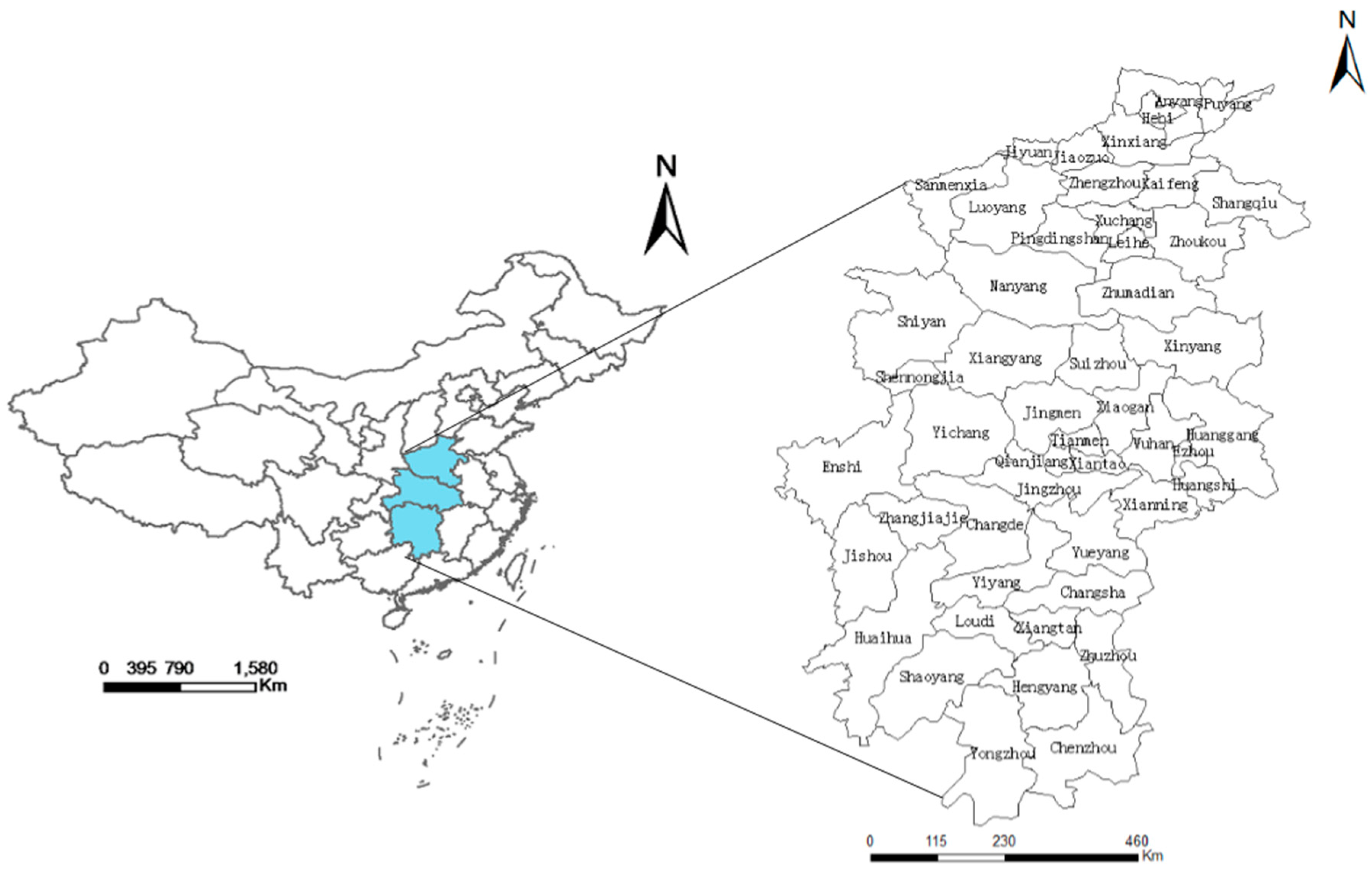
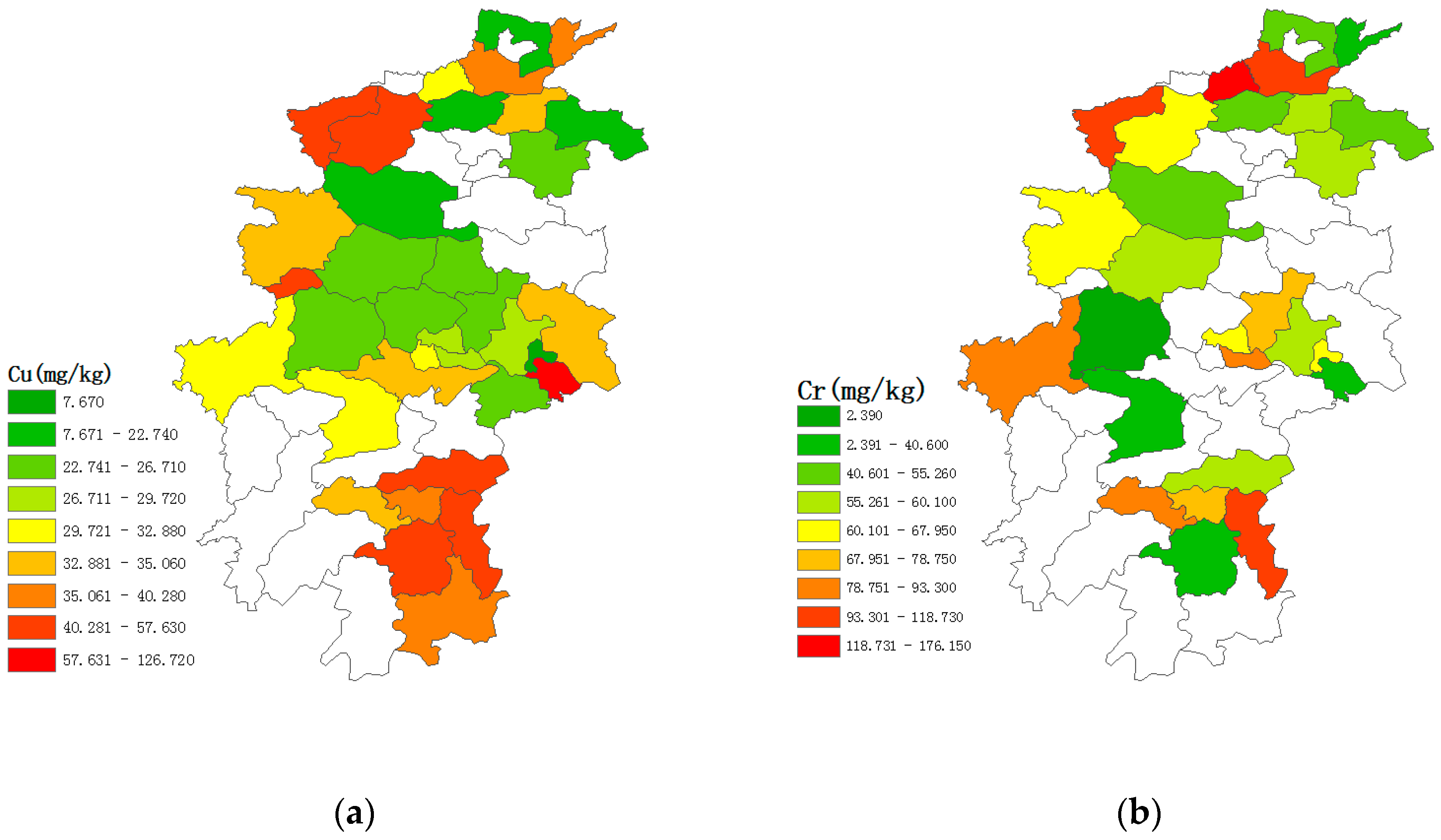
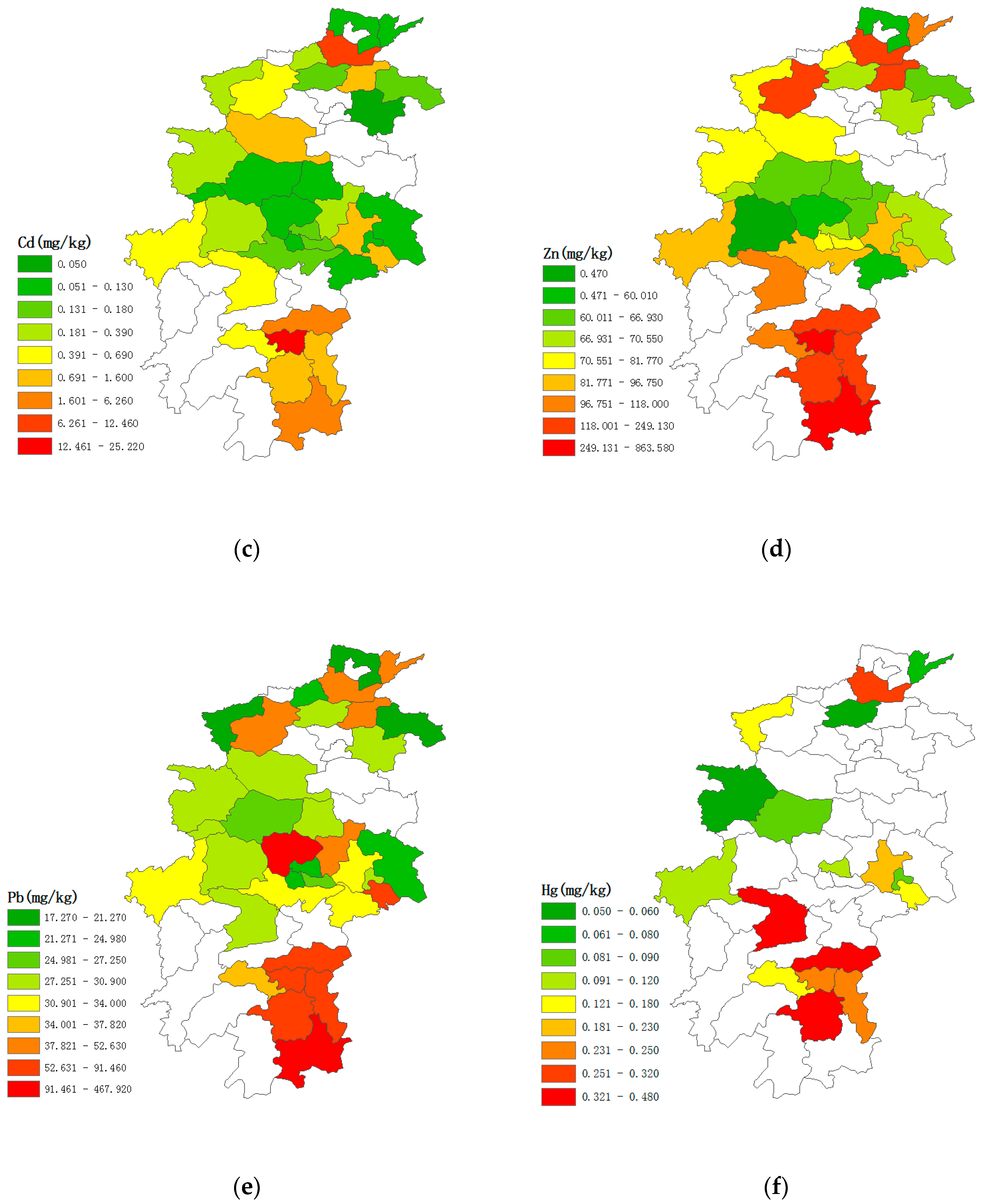
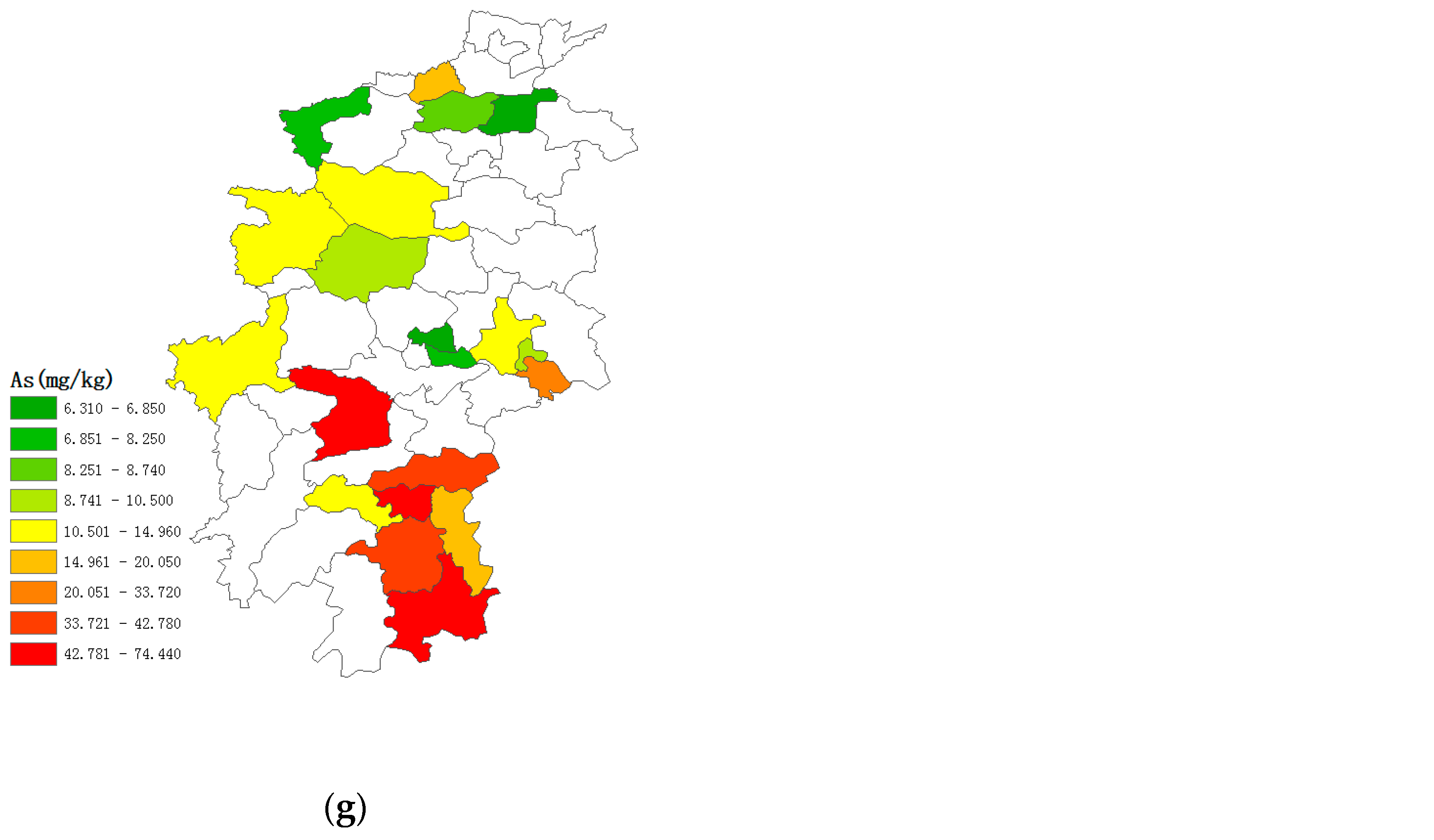
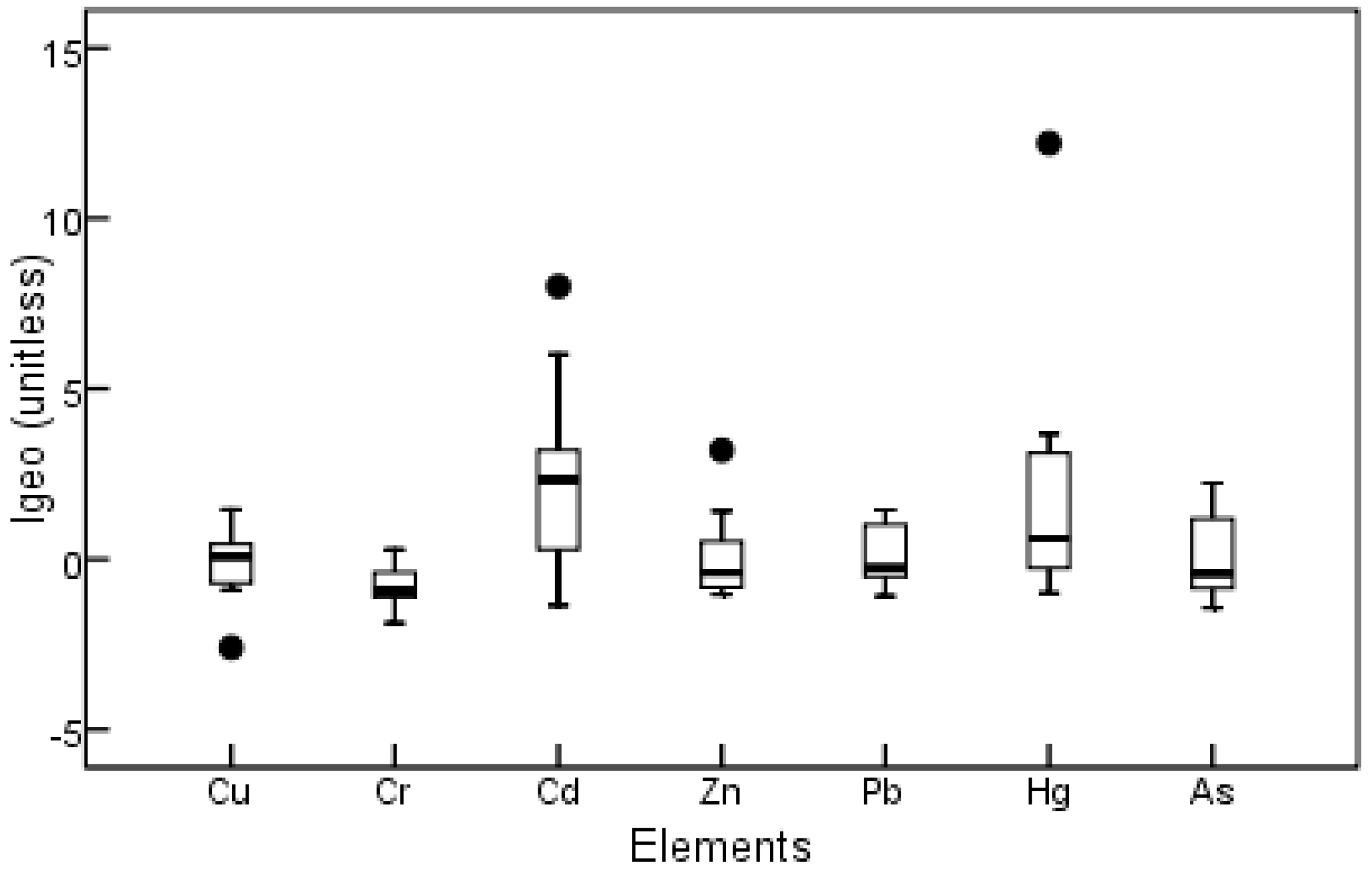
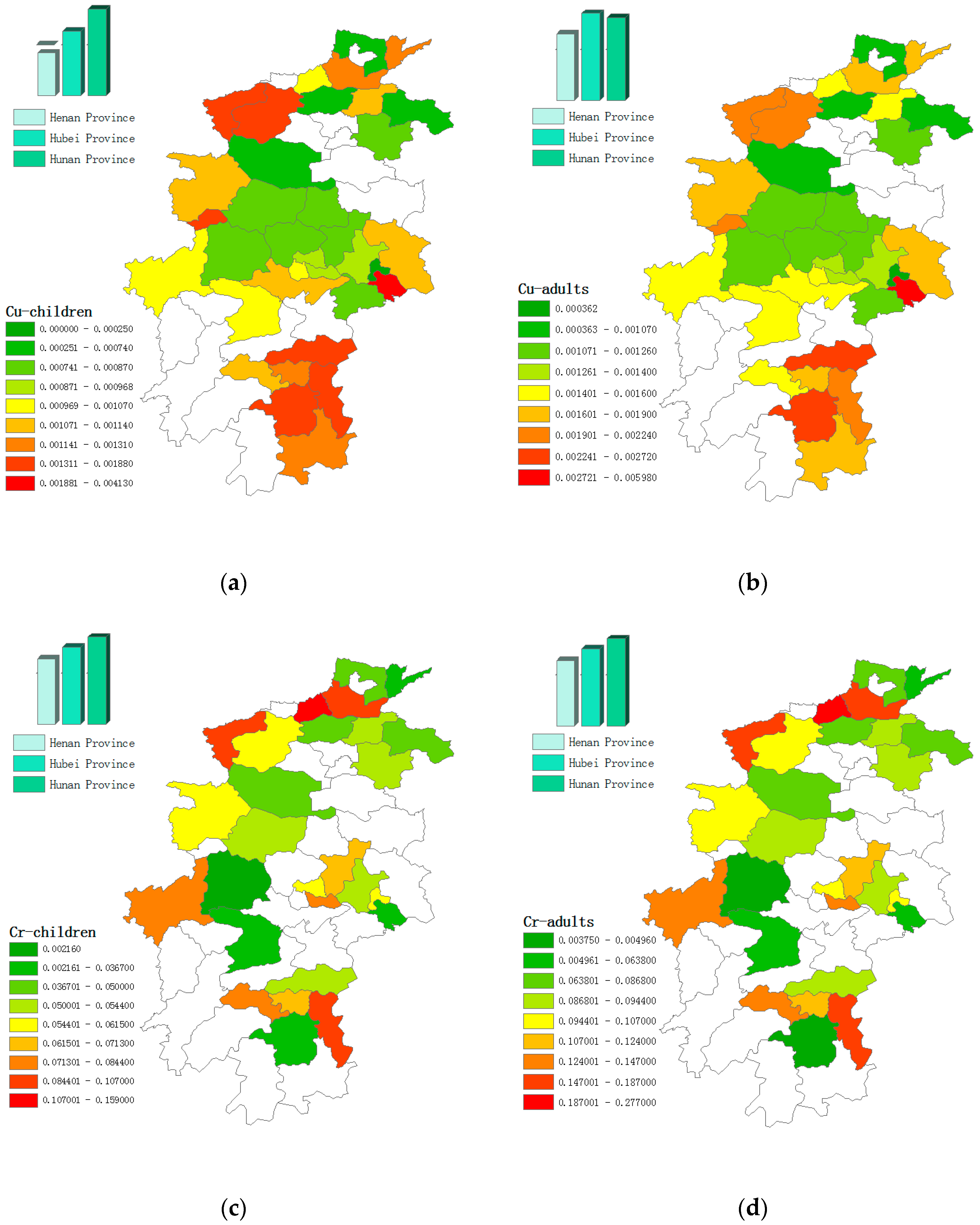
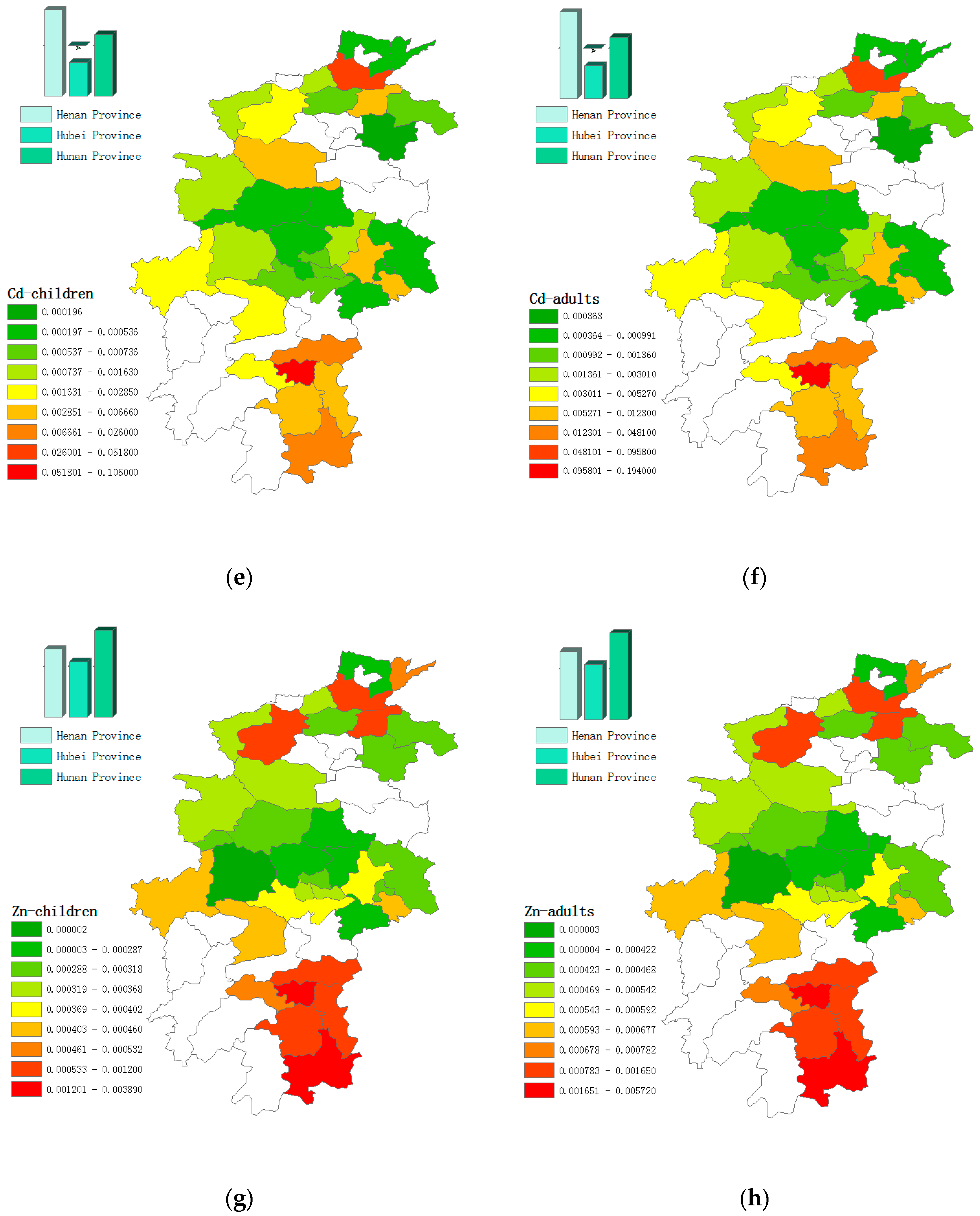
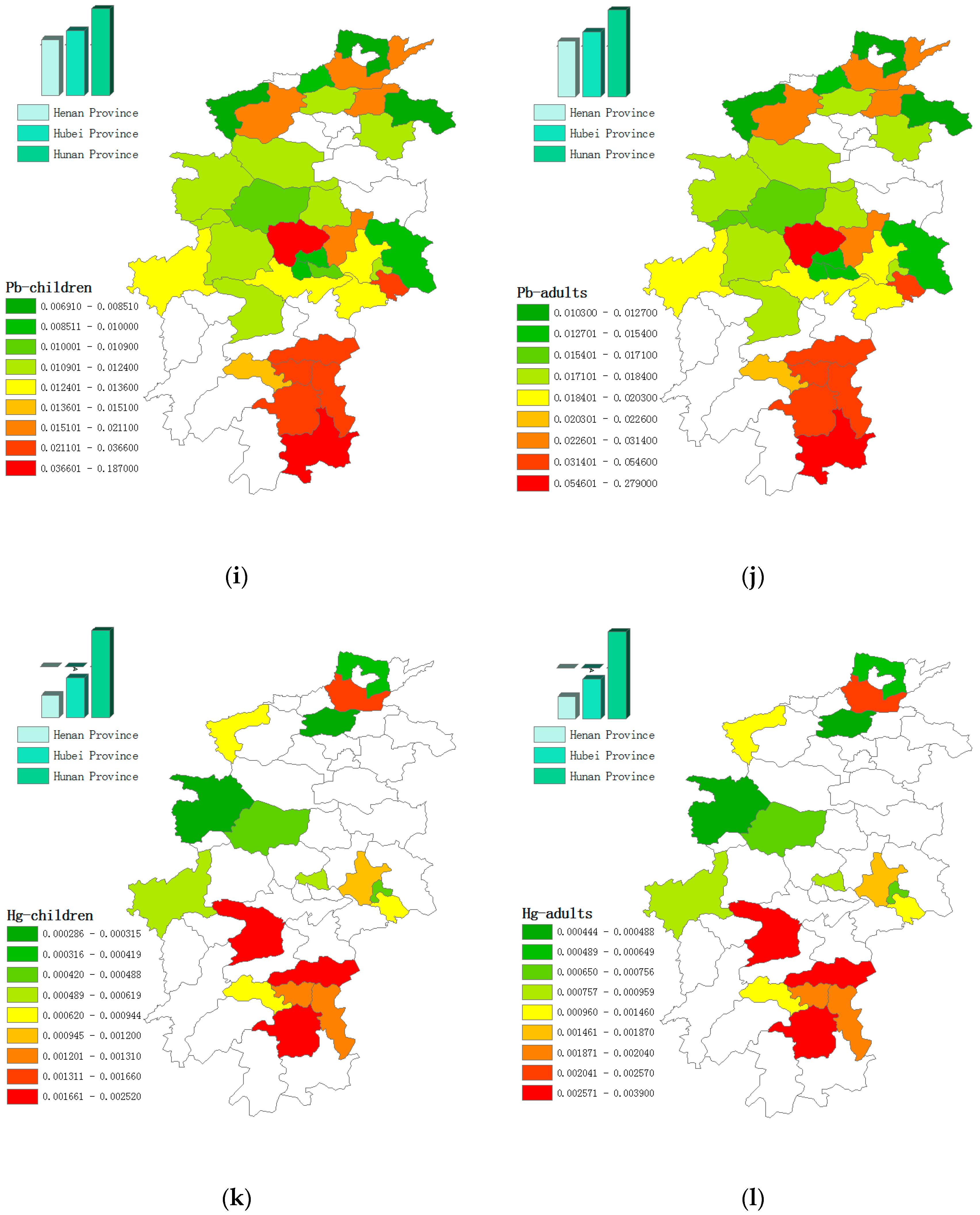
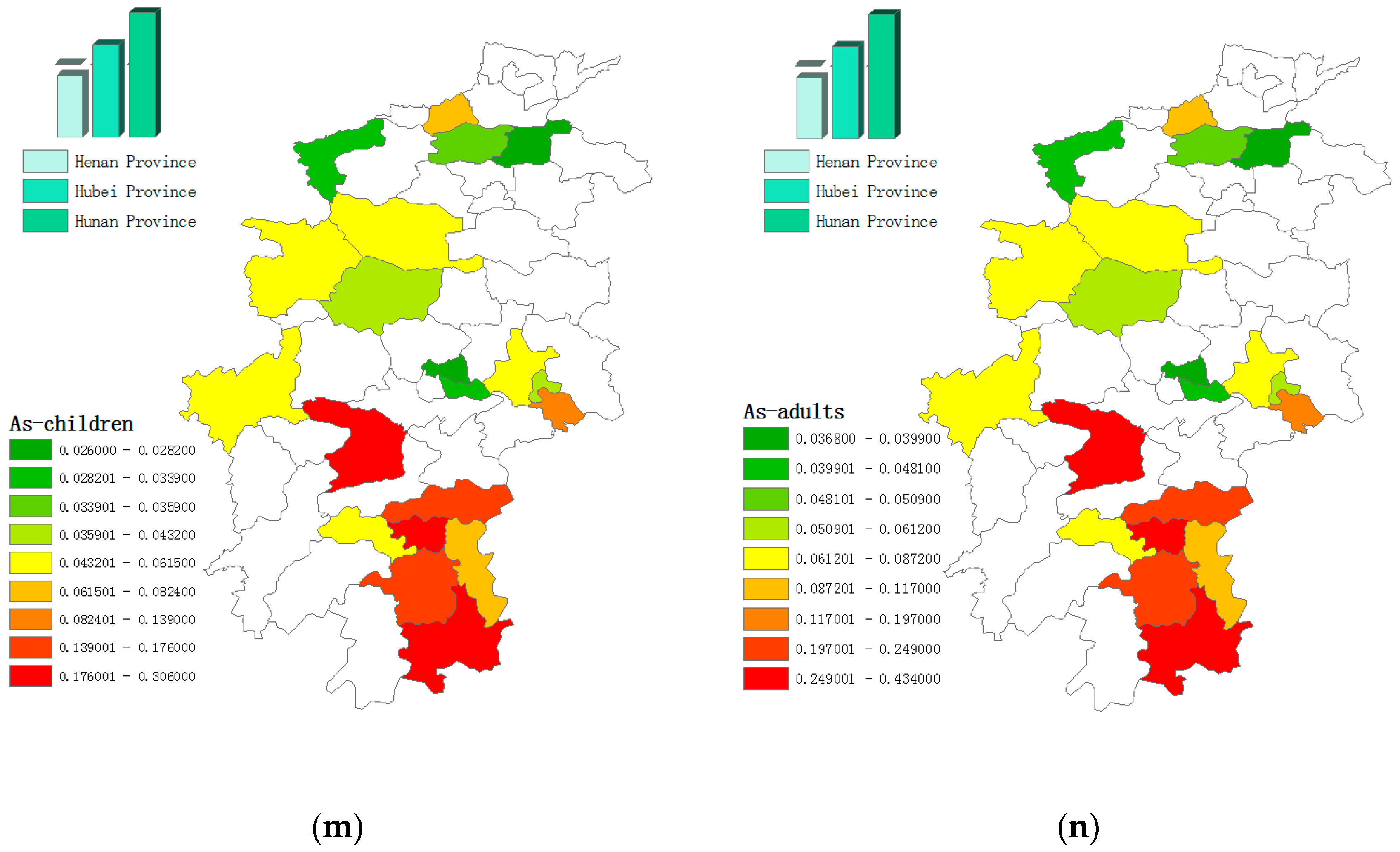
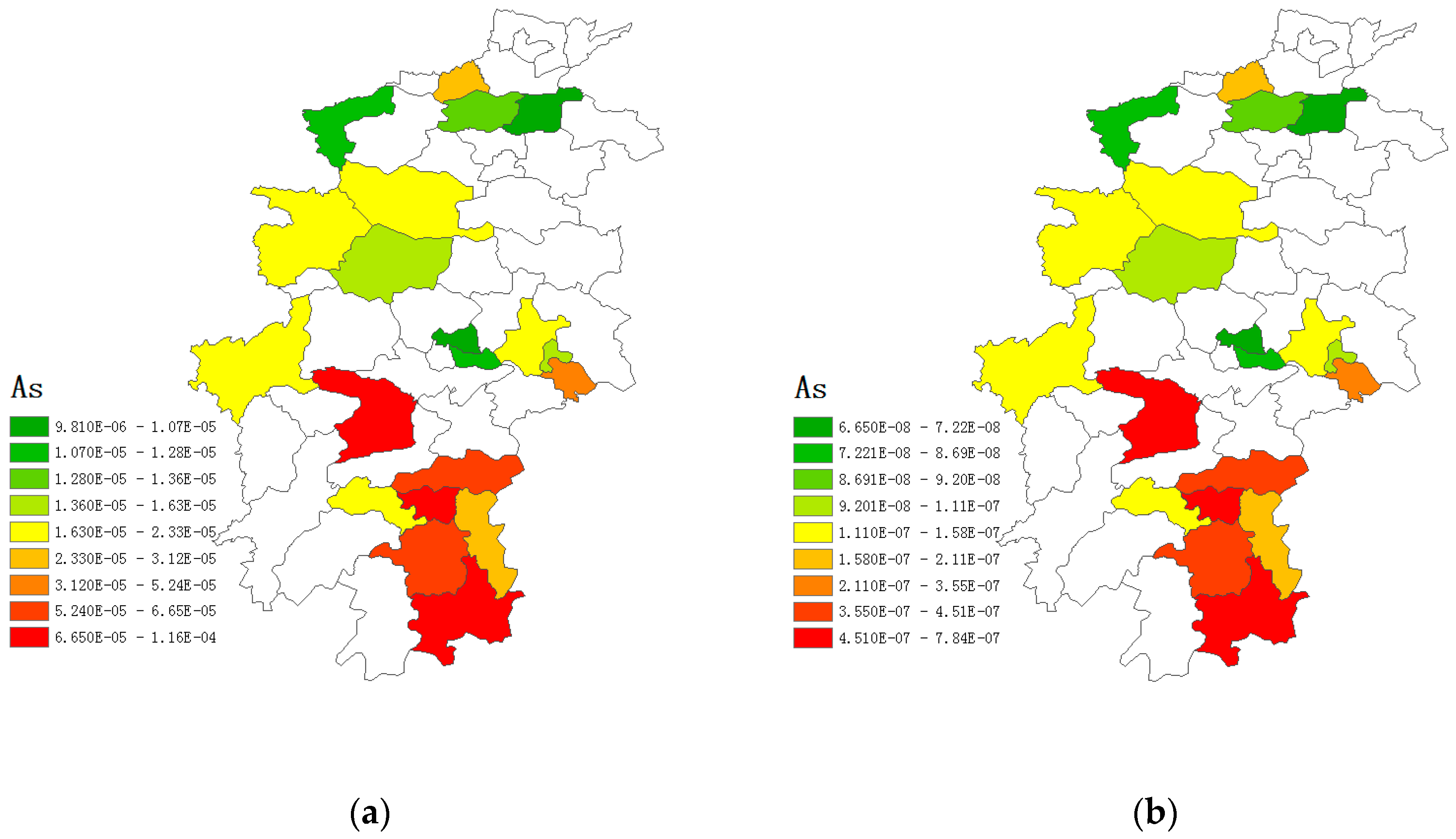
| Province | City | Cu | Cr | Cd | Zn | Pb | Hg | As | References |
|---|---|---|---|---|---|---|---|---|---|
| Henan Province | Kaifeng | 33.91 | 56.15 | 1.19 | 172.90 | 46.15 | 6.31 | [34,35,36] | |
| Luoyang | 47.38 | 66.47 | 0.65 | 190.25 | 51.23 | [37,38] | |||
| Jiaozuo | 31.57 | 176.15 | 0.39 | 81.43 | 24.32 | 17.25 | [39,40,41] | ||
| Zhengzhou | 21.82 | 54.46 | 0.16 | 70.55 | 30.90 | 0.05 | 8.74 | [42,43,44,45,46,47] | |
| Xinxiang | 40.28 | 116.83 | 12.46 | 219.93 | 52.63 | 0.32 | [33,48,49,50,51,52,53,54,55] | ||
| Zhoukou | 26.71 | 56.73 | 0.05 | 67.93 | 29.66 | [56,57] | |||
| Shangqiu | 22.42 | 55.26 | 0.18 | 66.93 | 19.51 | [58,59] | |||
| Sanmenxia | 45.25 | 118.73 | 0.25 | 81.77 | 21.27 | 0.16 | 7.97 | [38,60] | |
| Puyang | 36.20 | 40.60 | 0.13 | 118.00 | 49.20 | [61] | |||
| Anyang | 22.74 | 51.96 | 0.11 | 55.10 | 17.27 | 0.08 | [62] | ||
| Nanyang | 20.75 | 54.36 | 1.12 | 75.81 | 29.76 | 12.68 | [63,64] | ||
| Hubei Province | Enshi | 32.88 | 93.28 | 0.69 | 96.75 | 31.95 | 0.12 | 13.78 | [65,66,67,68,69,70] |
| Yichang | 26.31 | 2.39 | 0.26 | 0.47 | 29.16 | [70,71,72] | |||
| Wuhan | 28.75 | 59.02 | 1.60 | 87.73 | 34.00 | 0.23 | 12.92 | [70,73,74,75,76,77,78,79] | |
| Shiyan | 34.73 | 67.95 | 0.39 | 78.72 | 30.72 | 0.06 | 13.78 | [64,70,80] | |
| Tianmen | 27.89 | 67.94 | 0.16 | 69.97 | 23.02 | 0.11 | 6.85 | [70,81,82] | |
| Huangshi | 126.72 | 39.11 | 1.32 | 95.67 | 79.12 | 0.17 | 33.72 | [70,83,84,85,86,87,88,89] | |
| Xiaogan | 25.85 | 78.75 | 0.25 | 63.65 | 46.21 | [70,90,91] | |||
| Ezhou | 7.67 | 62.68 | 0.10 | 70.05 | 29.21 | 0.09 | 10.50 | [70,92] | |
| Xiangfan | 24.76 | 60.10 | 0.10 | 66.48 | 27.25 | 0.09 | 9.96 | [70,93] | |
| Xiantao | 29.72 | 87.30 | 0.14 | 77.29 | 25.82 | 8.25 | [70,94] | ||
| Huanggang | 35.06 | 0.12 | 70.15 | 24.15 | [70] | ||||
| Jingmen | 24.28 | 0.11 | 55.67 | 284.00 | [70] | ||||
| Jingzhou | 33.55 | 0.14 | 89.29 | 32.99 | [70] | ||||
| Qianjiang | 32.06 | 0.11 | 78.33 | 24.98 | [70] | ||||
| Shennongjia | 44.36 | 0.11 | 69.66 | 28.63 | [70] | ||||
| Suizhou | 24.46 | 0.13 | 63.35 | 30.10 | [70] | ||||
| Xianning | 24.87 | 0.11 | 60.01 | 31.98 | [70] | ||||
| Hunan Province | Changsha | 57.13 | 56.64 | 6.26 | 249.13 | 91.46 | 0.48 | 42.78 | [31,95,96] |
| Zhuzhou | 44.65 | 115.50 | 1.31 | 170.15 | 81.98 | 0.25 | 20.05 | [97,98,99,100] | |
| Changde | 31.47 | 26.00 | 0.49 | 102.08 | 29.43 | 0.45 | 68.86 | [101,102,103] | |
| Hengyang | 57.63 | 31.56 | 1.59 | 184.62 | 86.43 | 0.42 | 41.50 | [100,104,105] | |
| Xiangtan | 37.50 | 77.43 | 25.22 | 863.58 | 68.81 | 0.25 | 61.20 | [103,106] | |
| Chenzhou | 36.68 | 4.33 | 634.30 | 467.92 | 74.44 | [100,107,108] | |||
| Loudi | 33.26 | 93.03 | 0.59 | 107.24 | 37.82 | 0.18 | 14.96 | [109] |
| Parameter | Symbol | Units | Distribution |
|---|---|---|---|
| Soil ingestion rate | IngR | mg/day | 200 a; 100 b |
| Soil inhalation rate | InhR | m3/day | 7.6 a; 20 b |
| Exposure frequency | EF | day/year | 350 |
| Exposure duration | ED | year | 6 a; 24 b |
| Body weight | BW | kg | 15.9 a; 56.8 b |
| Exposure skin | SA | cm2 | 2448 a; 5075 b |
| Adherence factor | AF | mg/m2·day | 0.2 a; 0.07 b |
| Dermal absorption factor | ABS | unitless | 0.001 |
| Particle emission factor | PEF | m3/kg | 1.36 × 109 |
| Average contact time | AT | day | ED × 365 (non-carcinogens) |
| 74 × 65 (carcinogens) |
| Elements | RfD/(mg/kg·d) | SF/(kg·d/mg) | ||||
|---|---|---|---|---|---|---|
| ing | inh | dermal | ing | inh | dermal | |
| Cu | 4.00 × 10−2 | 4.02 × 10−2 | 1.20 × 10−2 | - | - | - |
| Cr | 3.00 × 10−3 | 2.86 × 10−5 | 6.00 × 10−5 | - | 42 | - |
| Cd | 1.00 × 10−3 | 1.00 × 10−3 | 1.00 × 10−5 | - | 6.3 | - |
| Zn | 3.00 × 10−1 | 3.00 × 10−1 | 6.00 × 10−2 | - | - | - |
| Pb | 3.50 × 10−3 | 3.52 × 10−3 | 5.25 × 10−4 | - | - | - |
| Hg | 3.00 × 10−4 | 3.00 × 10−4 | 2.40 × 10−5 | - | - | - |
| As | 3.00 × 10−4 | 1.23 × 10−4 | 3.00 × 10−4 | 1.5 | 15.1 | 3.66 |
| Cu | Cr | Cd | Zn | Pb | Hg | As | ||
|---|---|---|---|---|---|---|---|---|
| Central China | n | 16,565 | 14,506 | 16,974 | 16,376 | 17,108 | 11,784 | 12,089 |
| WA | 34.72 | 83.08 | 1.31 | 112.93 | 44.43 | 0.19 | 16.23 | |
| SD | 18.63 | 33.79 | 4.52 | 160.10 | 81.40 | 40.28 | 20.42 | |
| CV (%) | 1.51 | 1.72 | 6.88 | 3.35 | 3.85 | 18.09 | 3.93 | |
| Henan Province | n | 6983 | 6561 | 7094 | 6934 | 7011 | 6603 | 6895 |
| WA | 28.30 | 68.59 | 2.07 | 108.16 | 34.29 | 0.07 | 9.29 | |
| SD | 10.10 | 33.31 | 7.73 | 275.71 | 135.80 | 61.48 | 21.73 | |
| CV (%) | 3.38 | 7.86 | 17.95 | 11.93 | 14.97 | 27.80 | 6.30 | |
| Hubei Province | n | 6667 | 5090 | 6842 | 6375 | 6878 | 3790 | 3789 |
| WA | 37.09 | 80.69 | 0.80 | 87.82 | 39.91 | 0.12 | 14.00 | |
| SD | 24.21 | 24.62 | 0.44 | 21.00 | 60.37 | 0.05 | 7.93 | |
| CV (%) | 4.15 | 3.98 | 7.50 | 1.76 | 7.42 | 6.09 | 7.22 | |
| Hunan Province | n | 2915 | 2855 | 3038 | 3067 | 3219 | 1391 | 1405 |
| WA | 35.13 | 91.25 | 1.47 | 138.14 | 53.53 | 0.26 | 18.87 | |
| SD | 9.23 | 38.26 | 3.35 | 54.05 | 12.59 | 0.10 | 3.62 | |
| CV (%) | 2.64 | 4.14 | 19.88 | 4.26 | 3.18 | 16.07 | 5.59 | |
| BVChina a | 22.6 | 61 | 0.097 | 74.2 | 26 | 0.065 | 11.2 | |
| BVHenan b | 20 | 63.2 | 0.065 | 62.5 | 22.3 | 0.025 | 9.8 | |
| BVHubei c | 30.7 | 86 | 0.17 | 83.6 | 26.7 | 0.08 | 12.3 | |
| BVHunan d | 25 | 68 | 0.07 | 96 | 30 | 0.07 | 13.41 | |
| Class I e | 35 | 90 | 0.2 | 100 | 35 | 0.15 | 15 | |
| Class II e | 100 | 250 | 0.6 | 300 | 350 | 1.0 | 25 | |
| Class III e | 400 | 300 | 1.0 | 500 | 500 | 1.5 | 40 | |
| Elements | Province | Children | Adults | ||||||
|---|---|---|---|---|---|---|---|---|---|
| HQing | HQinh | HQdermal | HQ | HQing | HQinh | HQdermal | HQ | ||
| Cu | Henan | 8.53 × 10−3 | 2.37 × 10−7 | 6.96 × 10−5 | 8.60 × 10−3 | 1.19 × 10−3 | 1.75 × 10−7 | 1.41 × 10−5 | 1.21 × 10−3 |
| Hubei | 1.12 × 10−2 | 3.11 × 10−7 | 9.13 × 10−5 | 1.13 × 10−2 | 1.57 × 10−3 | 2.29 × 10−7 | 1.85 × 10−5 | 1.58 × 10−3 | |
| Hunan | 1.06 × 10−2 | 2.95 × 10−7 | 8.64 × 10−5 | 1.07 × 10−2 | 1.48 × 10−3 | 2.17 × 10−7 | 1.76 × 10−5 | 1.50 × 10−3 | |
| Cr | Henan | 2.76 × 10−1 | 8.08 × 10−4 | 3.38 × 10−2 | 3.10 × 10−1 | 3.86 × 10−2 | 5.95 × 10−4 | 6.86 × 10−3 | 4.61 × 10−2 |
| Hubei | 3.24 × 10−1 | 9.51 × 10−4 | 3.97 × 10−2 | 3.65 × 10−1 | 4.54 × 10−2 | 7.00 × 10−4 | 8.07 × 10−3 | 5.42 × 10−2 | |
| Hunan | 3.67 × 10−1 | 1.08 × 10−3 | 4.49 × 10−2 | 4.13 × 10−1 | 5.13 × 10−2 | 7.92 × 10−4 | 9.12 × 10−3 | 6.13 × 10−2 | |
| Cd | Henan | 2.50 × 10−2 | 6.97 × 10−7 | 6.11 × 10−3 | 3.11 × 10−2 | 3.49 × 10−3 | 5.14 × 10−7 | 1.24 × 10−3 | 4.73 × 10−3 |
| Hubei | 9.60 × 10−3 | 2.68 × 10−7 | 2.35 × 10−3 | 1.20 × 10−2 | 1.34 × 10−3 | 1.98 × 10−7 | 4.78 × 10−4 | 1.82 × 10−3 | |
| Hunan | 1.78 × 10−2 | 4.97 × 10−7 | 4.35 × 10−3 | 2.21 × 10−2 | 2.49 × 10−3 | 3.66 × 10−7 | 8.84 × 10−4 | 3.37 × 10−3 | |
| Zn | Henan | 4.35 × 10−3 | 1.22 × 10−7 | 5.32 × 10−5 | 4.40 × 10−3 | 6.09 × 10−4 | 8.95 × 10−8 | 1.08 × 10−5 | 6.20 × 10−4 |
| Hubei | 3.53 × 10−3 | 9.87 × 10−8 | 4.32 × 10−5 | 3.57 × 10−3 | 4.94 × 10−4 | 7.27 × 10−8 | 8.78 × 10−6 | 5.03 × 10−4 | |
| Hunan | 5.55 × 10−3 | 1.55 × 10−7 | 6.80 × 10−5 | 5.62 × 10−3 | 7.77 × 10−4 | 1.14 × 10−7 | 1.38 × 10−5 | 7.91 × 10−4 | |
| Pb | Henan | 1.18 × 10−1 | 3.28 × 10−6 | 1.93 × 10−3 | 1.20 × 10−1 | 1.65 × 10−2 | 2.42 × 10−6 | 3.92 × 10−4 | 1.69 × 10−2 |
| Hubei | 1.38 × 10−1 | 3.82 × 10−6 | 2.24 × 10−3 | 1.40 × 10−1 | 1.92 × 10−2 | 2.81 × 10−6 | 4.56 × 10−4 | 1.97 × 10−2 | |
| Hunan | 1.84 × 10−1 | 5.13 × 10−6 | 3.01 × 10−3 | 1.87 × 10−1 | 2.58 × 10−2 | 3.78 × 10−6 | 6.11 × 10−4 | 2.64 × 10−2 | |
| Hg | Henan | 2.63 × 10−3 | 7.35 × 10−8 | 8.05 × 10−5 | 2.71 × 10−3 | 3.68 × 10−4 | 5.42 × 10−8 | 1.64 × 10−5 | 3.85 × 10−4 |
| Hubei | 4.81 × 10−3 | 1.34 × 10−7 | 1.47 × 10−4 | 4.96 × 10−3 | 6.73 × 10−4 | 9.90 × 10−8 | 2.99 × 10−5 | 7.03 × 10−4 | |
| Hunan | 1.05 × 10−2 | 2.92 × 10−7 | 3.20 × 10−4 | 1.08 × 10−2 | 1.46 × 10−3 | 2.15 × 10−7 | 6.50 × 10−5 | 1.53 × 10−3 | |
| As | Henan | 3.73 × 10−1 | 2.55 × 10−5 | 9.14 × 10−4 | 3.74 × 10−1 | 5.23 × 10−2 | 1.87 × 10−5 | 1.86 × 10−4 | 5.25 × 10−2 |
| Hubei | 5.63 × 10−1 | 3.84 × 10−5 | 1.38 × 10−3 | 5.64 × 10−1 | 7.88 × 10−2 | 2.83 × 10−5 | 2.80 × 10−4 | 7.91 × 10−2 | |
| Hunan | 7.59 × 10−1 | 5.17 × 10−5 | 1.86 × 10−3 | 7.61 × 10−1 | 1.06 × 10−1 | 3.81 × 10−5 | 3.77 × 10−4 | 1.07 × 10−1 | |
| Elements | Province | Children | Adults | ||||||
|---|---|---|---|---|---|---|---|---|---|
| CRing | CRinh | CRdermal | CR | CRing | CRinh | CRdermal | CR | ||
| Cr | Henan | — | 9.71 × 10−8 | — | 9.71 × 10−8 | — | 7.15 × 10−7 | — | 7.15 × 10−7 |
| Hubei | — | 1.14 × 10−7 | — | 1.14 × 10−7 | — | 8.41 × 10−7 | — | 8.41 × 10−7 | |
| Hunan | — | 1.29 × 10−7 | — | 1.29 × 10−7 | — | 9.51 × 10−7 | — | 9.51 × 10−7 | |
| Cd | Henan | — | 4.39 × 10−9 | — | 4.39 × 10−9 | — | 3.24 × 10−9 | — | 3.24 × 10−9 |
| Hubei | — | 1.69 × 10−9 | — | 1.69 × 10−9 | — | 1.25 × 10−9 | — | 1.25 × 10−9 | |
| Hunan | — | 3.13 × 10−9 | — | 3.13 × 10−9 | — | 2.30 × 10−9 | — | 2.30 × 10−9 | |
| As | Henan | 1.68 × 10−4 | 4.73 × 10−8 | 1.00 × 10−6 | 1.69 × 10−4 | 2.35 × 10−5 | 3.48 × 10−8 | 2.04 × 10−7 | 2.38 × 10−5 |
| Hubei | 2.53 × 10−4 | 7.13 × 10−8 | 1.51 × 10−6 | 2.55 × 10−4 | 3.55 × 10−5 | 5.25 × 10−8 | 3.07 × 10−7 | 3.58 × 10−5 | |
| Hunan | 3.41 × 10−4 | 9.60 × 10−8 | 2.04 × 10−6 | 3.44 × 10−4 | 4.78 × 10−5 | 7.07 × 10−8 | 4.14 × 10−7 | 4.83 × 10−5 | |
| Cu | Cr | Cd | Zn | Pb | Hg | As | |
|---|---|---|---|---|---|---|---|
| Cu | 1 | ||||||
| Cr | −0.073 | 1 | |||||
| Cd | 0.130 | 0.124 | 1 | ||||
| Zn | 0.146 | 0.102 | 0.840 ** | 1 | |||
| Pb | 0.112 | −0.091 | 0.153 | 0.515 ** | 1 | ||
| Hg | −0.064 | 0.121 | −0.088 | −0.059 | −0.062 | 1 | |
| As | 0.227 | −0.324 | 0.535 * | 0.716 ** | 0.639 ** | −0.119 | 1 |
© 2018 by the authors. Licensee MDPI, Basel, Switzerland. This article is an open access article distributed under the terms and conditions of the Creative Commons Attribution (CC BY) license (http://creativecommons.org/licenses/by/4.0/).
Share and Cite
Li, F.; Cai, Y.; Zhang, J. Spatial Characteristics, Health Risk Assessment and Sustainable Management of Heavy Metals and Metalloids in Soils from Central China. Sustainability 2018, 10, 91. https://doi.org/10.3390/su10010091
Li F, Cai Y, Zhang J. Spatial Characteristics, Health Risk Assessment and Sustainable Management of Heavy Metals and Metalloids in Soils from Central China. Sustainability. 2018; 10(1):91. https://doi.org/10.3390/su10010091
Chicago/Turabian StyleLi, Fei, Ying Cai, and Jingdong Zhang. 2018. "Spatial Characteristics, Health Risk Assessment and Sustainable Management of Heavy Metals and Metalloids in Soils from Central China" Sustainability 10, no. 1: 91. https://doi.org/10.3390/su10010091





